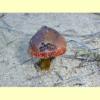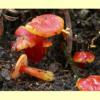


The other two subgenera of Hygrocybe (Cuphophyllus and Pseudohygrocybe) are keyed out separately.
Bougher, N.L. & Syme, K. (1998), Fungi of Southern Australia. University of Western Australia Press, Nedlands. [Description, Illustration and Microcharacters of H. conica and H. polychroma]
Bougher, N.L. & Young, A.M. (1997), Hygrophoraceae of Western Australia, Mycotaxon 63: 25–35, and 65: 525 for errata. [Description and Microcharacters of H. conica and H. polychroma, and Illustration of H. polychroma]
Fuhrer, B. (2005), A Field Guide to Australian Fungi. Bloomings Books, Hawthorn. [Description and Illustration of H. astatogala, H. conica and H. persistens]
Fuhrer, B. & Robinson, R. (1992), Rainforest Fungi of Tasmania and South-east Australia. CSIRO Press, East Melbourne. [Illustration of H. astatogala (as Bertrandia)]
Grgurinovic, C.A. (1997a), Larger Fungi of South Australia. The Botanic Gardens of Adelaide and State Herbarium and The Flora and Fauna of South Australia Handbooks Committee, Adelaide. [Description, Illustration and Microcharacters of H. astatogala]
Horak, E. (1990), Monograph of the New Zealand Hygrophoraceae (Agaricales), New Zealand J. Bot. 28: 255–309. [Description, B&W Illustration and Microcharacters of H. astatogala (as Bertrandia)]
Young, A.M. (1999b), A field key to the Hygrophoraceae of south-eastern Australia, Australas. Mycol. 18: 63–69. [Field Key to known species]
Young, A.M. (1999a), The Hygrocybeae (Fungi, Basidiomycota, Agaricales, Hygrophoraceae) of the Lane Cove Bushland Park, New South Wales, Austrobaileya 5: 535–564. [Description and Microcharacters of H. astatogala]
Young, A.M. (2000b), Additions to the Hygrophoraceae (Fungi, Agaricales) of south-eastern Australia, Muelleria 13: 1–36. [Description and Microcharacters of H. conica, H. persistens and H. siccitatopapillata and B&W Illustration of H. persistens]
Young, A.M. (2002a), Further Hygrophoraceae of Victoria, Australas. Mycol. 20: 115–117. [Description and Microcharacters of H. conica var. conicoides and Description, B&W Illustration and Microcharacters of H. persistens]
Young, A.M. (2005a), Fungi of Australia: Hygrophoraceae, Australian Biological Resources Study, Canberra & CSIRO Publishing, Melbourne. [Description, B&W Illustration and Microcharacters of all Australian species, along with Illustration of most species and a Key to species]
Young, A.M. (2005b), A Field Guide to the Fungi of Australia. University of New South Wales Press, Sydney. [Description and B&W Illustration of H. astatogala]
Young, A.M. & Mills, A.K. (2002), The Hygrophoraceae of Tasmania, Muelleria 16: 3–28. [Discussion of Tasmanian collections of H. astatogala]
Young, A.M. & Wood, A.E. (1997), Studies on the Hygrophoraceae (Fungi, Homobasidiomycetes, Agaricales) of Australia, Austral. Syst. Bot. 10: 911–1030 [Description, B&W Illustration and Microcharacters of H. astatogala, H. austrolutea, cerasinomutata, H. chlorophana (as H. flavescens), H. conica, H. cystidiorubra, H. kandoora, H. rubrolutea, H. siccitatopapillata and H. wilsonensis]
Young, A.M., Bougher, N.L. & Robinson, R.M. (2000), Hygrophoraceae of Western Australia II. Further taxa, Australas. Mycol. 19: 41–48. [Description, Illustration and Microcharacters of H. austrolutea]
